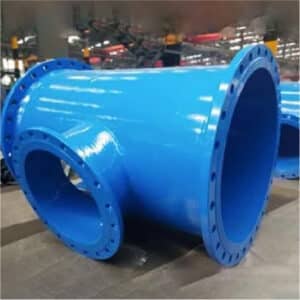MJ Fittings
MJ fitting means Mechanical Joint pipe fitting,The mechanical joint fitting is usually fitted with a gland, rubber gasket and carbon steel T-bolt , when the bolt is tightened, squeezes the rubber ring through the gland, thus making the connection to the socket end. The advantage of this type of connection is that it can be used without the need for welding or any other type of jointing. The mechanical joint fitting is a reliable and efficient way to connect pipes.
An MJ fitting, also known as a Mechanical Joint fitting, is a type of pipe fitting used in water supply systems and sewer systems. It is designed to connect ductile iron pipes and is commonly used in municipal water and wastewater projects. The key components of an MJ fitting typically include:
Gland (follower)
(as below Figure No.2)
_
This is a metal ring that is placed over the spigot (plain end) of the pipe.
Gasket
(as below Figure No.3)
_
A rubber or synthetic seal that fits between the gland and the pipe spigot to ensure a watertight connection.
Bolts and nuts (as below Figure No.4)
_
These are used to tighten the gland against the pipe, compressing the gasket to create a secure, leak-proof seal.
Socket (as below Figure No.1 )
_
The bell end of the pipe or fitting that the spigot end is inserted into.
MJ fittings are known for their ease of installation and flexibility in terms of alignment adjustments, which make them highly popular for underground piping systems.
MJ fitting drawing

MJ fitting dimension
Ductile iron pipe with Mechanical Joint(K type)
| Nominal Diameter DN | DE(mm) | D2(mm) | D1(mm) | t | Hole Size x No. | Gland Mass(kg) |
|---|---|---|---|---|---|---|
| 80 | 98 | 168 | 205 | 80 | M18X4 | 4.1 |
| 100 | 118 | 188 | 234 | 80 | M23X4 | 5.7 |
| 150 | 170 | 242 | 288 | 80 | M23X6 | 7.5 |
| 200 | 222 | 295 | 341 | 80 | M23X6 | 9.5 |
| 250 | 274 | 349 | 395 | 80 | M23X8 | 12.2 |
| 300 | 326 | 409 | 455 | 110 | M23X8 | 14.6 |
| 350 | 378 | 462 | 508 | 110 | M23X10 | 17.2 |
| 400 | 429 | 515 | 561 | 110 | M23X12 | 22.9 |
| 450 | 480 | 568 | 614 | 110 | M23X12 | 28.5 |
| 500 | 532 | 621 | 667 | 110 | M23X14 | 38.6 |
| 600 | 635 | 727 | 773 | 110 | M23X14 | 47.4 |
| 700 | 738 | 838 | 892 | 120 | M27X16 | 61.9 |
| 800 | 842 | 942 | 999 | 120 | M27X20 | 63.8 |
| 900 | 945 | 1057 | 1123 | 120 | M33X20 | 68.5 |
| 1000 | 1048 | 1160 | 1231 | 130 | M33X20 | 82.5 |
| 1200 | 1255 | 1378 | 1444 | 130 | M33X28 | 104 |
| 1400 | 1462 | 1591 | 1657 | 130 | M33X28 | 119 |
| 1600 | 1668 | 1808 | 1874 | 160 | M33X30 | 123 |
| 1800 | 1675 | 2023 | 2089 | 170 | M33X34 | 162 |
| 2000 | 2082 | 2239 | 2305 | 180 | M33X36 | 196 |
MJ fitting types
MJ fittings come in various types to accommodate different piping configurations and requirements.
Here are some common types of MJ fittings:
MJ Coupling(also called MJ Collar)
_
Used to join two pipes together.
MJ Reducer
_
Connects pipes of different diameters, reducing the size from a larger pipe to a smaller one.
MJ Tee
_
Allows for a perpendicular connection, branching off from the main pipe.
MJ Elbow (90° or 45°)
_
Used to change the direction of the pipe by 90 degrees or 45 degrees.
MJ Cap
_
Seals the end of a pipe, capping off the flow.
MJ Plug
_
Similar to a cap but used to close off a fitting instead of a pipe end.
MJ Adapter
_
Connects pipes with different types of ends, such as from a mechanical joint to a flange or a threaded connection.
MJ Cross
_
Allows for branching off in four directions from a single point.
These fittings are essential for creating a versatile and adaptable piping system in various municipal and industrial applications.
Below are judberd design for MJ fitting , for small size(smaller than or equal to DN1000) ,we have a light weight gland(as below MJ collar and MJ Elbow design) , for big size (bigger than DN1000),we have a heavy gland( as below MJ tee design)

MJ collar fitting according to EN545/ISO2531

MJ Elbow fitting according to EN545/ISO2531

MJ tee fitting according to EN545/ISO2531
MJ fitting installation
Installing an MJ (Mechanical Joint) fitting involves several steps to ensure a secure and leak-proof connection.
Here is a general guide for installing an MJ fitting:
Materials Needed
MJ fitting (e.g., coupling, elbow, tee)
Gasket
Gland (follower)
Bolts and nuts
Pipe sections to be joined
Lubricant
Wrenches or torque wrench
Steps for Installation
1. Prepare the Pipe Ends
_
● Clean the pipe ends thoroughly to remove any dirt, debris, or rust.
● Ensure the pipe ends are smooth and free from any sharp edges or burrs.
2. Lubricate the Gasket and Pipe
_
● Apply a suitable lubricant to the gasket and the plain end (spigot) of the pipe. This helps in easy insertion and proper seating of the gasket.
3. Place the Gland and Gasket
_
● Slide the gland (follower) over the spigot end of the pipe.
● Place the gasket on the spigot end of the pipe, ensuring it is evenly positioned and not twisted.
4. Insert the Pipe into the Socket
_
● Insert the spigot end of the pipe into the socket (bell end) of the MJ fitting. Ensure the gasket is properly seated in the bell.
● Push the pipe in until it fully seats against the fitting.
5. Position the Gland
_
● Slide the gland up against the gasket, ensuring it is evenly positioned around the pipe.
6. Insert and Tighten the Bolts
_
● Insert the bolts through the holes in the gland and the socket flange.
Hand-tighten the nuts onto the bolts to ensure even alignment.
7. Torque the Bolts
_
● Using a wrench or torque wrench, tighten the bolts in a crisscross pattern (alternating across from one another) to ensure even pressure on the gasket.
● Continue tightening until the specified torque value is reached. The exact torque value will depend on the size of the fitting and the manufacturer‘s recommendations.
8. Check for Proper Installation
_
● Inspect the fitting and the pipe connection to ensure the gasket is evenly compressed and there are no visible gaps.
● Check for leaks by pressurizing the system and monitoring the joint.
Tips for Successful Installation
● Follow the manufacturer‘s instructions and torque specifications carefully.
● Ensure all components (gasket, gland, bolts, and nuts) are compatible and in good condition.
● Use a torque wrench to avoid over-tightening, which can damage the gasket and fitting.
● Regularly inspect and maintain the joints as part of your piping system maintenance routine.
Proper installation of MJ fittings is crucial for the reliability and longevity of the piping system, ensuring a secure and leak-free connection.
Judberd offers a complete range of mechanical joint pipe fitting from DN60 to DN2000 in accordance with EN545. the main difference to conventional t-joints is that the spigot end of the pipe is inserted into a metal sleeve, which is then pushed into the socket end of the pipe. this creates a more robust connection that can withstand greater force and movement without leaks. this type of connection is often used in applications where the ground is not very flat or where there is movement, as it prevents the spigot end of the pipe from falling out of the socket end or being deflected. this can cause leaks at the socket and socket joint.
If you require any further information about our mechanical joint fittings, please do not hesitate to contact us. our team will be more than happy to help.
Ductile iron mechanical joints are available in working pressure ratings of PN10, PN16, PN25. the test pressure is 1.5 times of the working pressure.
Fittings for water supply generally have a cement lining in accordance with ISO4179 and are coated with zinc&bitumen according to ISO8179 on the outside. or surface FBE coating according to EN14901. other finishes are also possible according to the actual use of the customer.
However, compared to normal t-joint fittings, mj fittings are more expensive. this is why MJ fittings are not very common.
RFQ
Mechanical joint vs Flange
FLEXIBILITY
MJ fittings offer more flexibility and can accommodate minor misalignments and ground movements, while flange joints are rigid and require precise alignment.
STRENGTH
Flange joints are stronger and better suited for high-pressure applications compared to MJ fittings.
INSTALLATION
MJ fittings are generally easier to install in the field, especially for underground applications, while flange joints can be more labor-intensive but offer easier disassembly for maintenance.
APPLICATIONS
MJ fittings are commonly used in water and sewer systems, particularly underground, while flange joints are used above-ground systems, and high-pressure environments.
Choosing between MJ and flange joints depends on the specific requirements of the piping system,
including the need for flexibility, pressure rating, ease of installation, and maintenance considerations.
Mechanical joint vs Restrained joint
FLEXIBILITY
Mechanical joints offer more flexibility, allowing for minor misalignments and ground movements, while restrained joints are designed to prevent axial movement and provide a rigid connection.
STRENGTH
Restrained joints provide a stronger connection, ideal for high-pressure applications and areas with significant external forces, while mechanical joints are suitable for standard applications with moderate pressure.
INSTALLATION
Mechanical joints are generally easier to install and require less precise alignment, while restrained joints can be more complex and require careful installation to ensure proper restraint.
Cost
Mechanical joints are typically less expensive than restrained joints due to their simpler design and fewer components.
Choosing between mechanical joints and restrained joints depends on the specific requirements of the piping system,
including the need for flexibility, pressure rating, resistance to external forces, and budget considerations.







